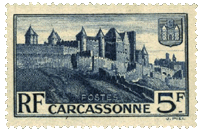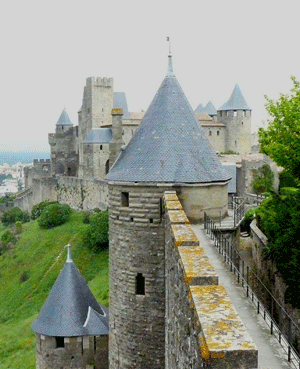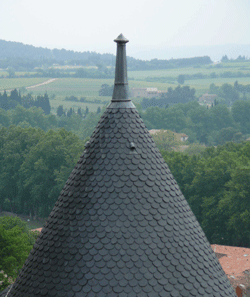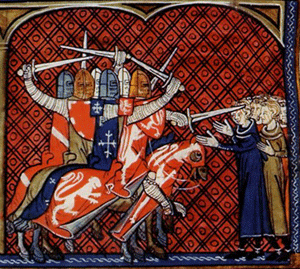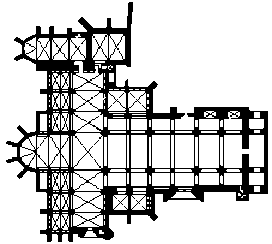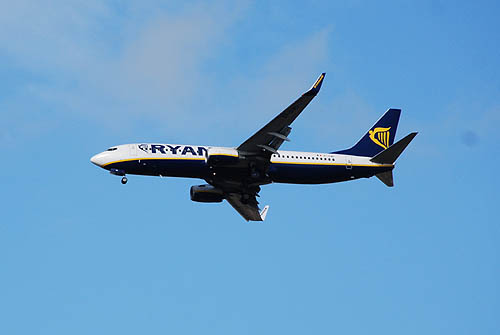|
||||||||||||||||||||||||||||||||||||||||||||||||||||||||||||||||||||||||||||||||||||||||||||||||||||||||||||||||||||||
Click below for
The Cité and the Château Comtal.The French word cité does translate as city. It translates as walled town. This explains why the cité in Carcassonne occupies only a tiny area of the modern city. The present cité is essentially medieval, although there are traces of older structures, for example some of the towers on the inner ring of defensive walls still retain their distinctive Roman shape and even their Roman foundations.
A large part of the structure dates from the pre-French period, including the inner city walls and part of the Viscounts’ castle known as the chateau Comtal. The outer defensive walls and the barbican of the chateau Comtal are French, added in the thirteenth century, and all of it was heavily restored in the nineteenth century. Before the French period it was home to the distinctive Occitan concept of paratge, as well as to the rich culture of the troubadours and the Cathars.
The folk etymology of the name Carcassonne is endearing and widely
believed. According to the story a châtelaine of the city,
named Carcas, foiled a attempted seige by the Franks or in some
versions the Saracen
The Basilica of saint Nazaire
History of the CitéThe earliest known evidence of settlement in the region have been dated to around 3500 BC. Signs of Pre-Roman (Iberian) habitation in this area date from the 5th century BC. The hill site or oppidum of Carsac became an important trading place in the 6th century BC. (Carsac is a Celtic place-name). A people known as the Volcae Tectosages fortified the oppidum there. In 122 BC the Romans invaded the areas that we now know as Provence and Languedoc. Recognising its strategic importance Carcassonne fortified the hilltop around 100 BC and later made it the colonia of Julia Carsaco, later Carcasum. The lower courses of the inner ring of ramparts to the north date from Gallo-Roman times. This Roman settlement was occupied until the mid 5th century AD when it, along with Spain, fell to the Visigoths, invaders from the banks of the Danube. The Visigothic king Theodoric II took Carcassonne in 453, and a few years later in 462 the Romans ceded the whole area (Septimania) too. Theodoric built further fortifications at Carcassonne, now a frontier post on the northern marches of his kingdom. Traces of these fortifications still stand. Theodoric, an Arian Christian, is thought to have begun the building of a church now replaced by the basilica in the Cité dedicated to Saint Nazaire. In 508 the Visigoths repelled attacks of the Frankish king Clovis. Saracens from Barcelona took Carcassonne in 725, but the Franks soon returned and in 759. King Pippin the Younger drove most of the Saracens away. By 760, Pippin had taken most of what is now the south of France, although he was unable to penetrate Carcassonne. Carcassonne remained under Visigoth rule from 460 to 725. A Visigothic walled city was built in the 5th century by Euric I, King of the Visigoths. In 508 it withstood attack by Frankish king, Clovis I, but fell to the Moors (Saracens) in 725. The Moorish walled city was renamed Carchachouna. A generation or so later, in 752, the Moors gave way to the Caroligian king, Pépin the Short, who did manage to take Carcassonne, making it a Frankish City.
Click on this link for more on the Carcassonne's
role in the Cathar Wars In 1247, King Louis IX of France founded the new part of the town across the river - the Bastide de Saint Louise, now in the heart of the ville basse. Louis (Saint Louis) and his successor Philip III built the present outer ramparts of the old Cité. Opinion at the time considered the fortress to be impregnable. Indeed, when Edward the Black Prince attacked Carcassonne in 1355 during the Hundred Years' War, his troops destroyed the Ville Basse without much trouble, but he failed to take the old Cité.
Photographs
Click on the following link for photographs of the Ville Basse (The Bastide de St-Louis where the penthouse is located)
Things to see and do within the Medieval City
|
||||||||||||||||||||||||||||||||||||||||||||||||||||||||||||||||||||||||||||||||||||||||||||||||||||||||||||||||||||||
|
Medieval City Open all year |
The mediaeval walled town lies on the right bank of the River Aude and is featured on UNESCO’s World Heritage list. It has 52 towers and 2 rings of town walls making a total of 3 km of battlements. There is no restriction on access to this area of Carcassonne. It is still home today to its population of approximately 120 and it boasts a large number of shops and craftsmen. |
|
Castle
and ramparts October through March : 9:30am to 5:00pm April through
September : 9:30am to 6:30pm |
The ultimate stronghold, built in the 12th century, it was the home of the Trencavels, vicomtes of Carcassonne. Guided tours, gallery talks, educational activities (for children). Lapidary museum, permanent exhibition on the restoration of the Cité in the 19th century. |
|
Basilica
of Saint-Nazaire Open all year. Weekdays: from 9.00am to 11.45pm and 1.45pm
to 6pm (closes at 5pm during the winter) - Sundays: from
9.00am to 10.45am and 2pm to 5pm (closes at 4:30pm during
the winter). |
Cathedral from the 11th and 14th century. |
|
Birds
City Open from 1 April to 6 November from 2pm to 6pm. |
800 metres from the Cité, in the commune of Pech Mary, you can see demoonstrations of falconry. |
|
Cultural Centre in Memorial of Former Soldiers Monday to Friday from 9am to 12pm and 2.30pm to 5pm. Open
Saturdays and Sundays upon appointment. |
Exhibition. Retrospective of military history supported by objects, costumes, accessories, documents |
|
Museum of Chivalry, Arms and Archery Open every day from 10am to 7pm between Easter and end
of October, Mondays excepted. Guided visits available –
please enquire. |
Exhibition |
|
Museum of the Middle Ages Open all year except during Christmas holidays : 10am to
7pm |
Sound and light video and scale model of the Roman Medieval Walled City, costumes, architecture, weapons, military assault and defence techniques used in Medieval Castles |
|
School Museum Open all year except january from 10am to 6pm (7pm in summer) |
Reconstruction of a classroom in old times. Exhibition of documents, furniture and school material from the time of Jules Ferry. |
|
Sightseeing tour by train Open from 1 May through 30 September |
Take the little train for a sightseeing tour of the Medieval City's turrets and ramparts (Duration 20 min. Multi-language explanations). Departures from the Narbonnaise Gate. |
|
Tour
in a horse-drawn carriage Open from 1 April to 31 October from 10am to 6pm. |
Guided tour of Carcassonne in a horse-drawn carriage. 20-minute commentary. Route takes you between the two ramparts on the fortified walls, departing from Porte Narbonnaise. |




 s.
s.
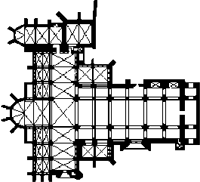


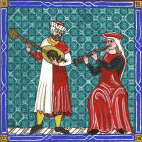
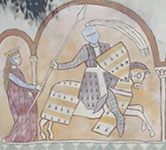
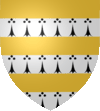 For
over a century the
For
over a century the  In
1240
In
1240 
